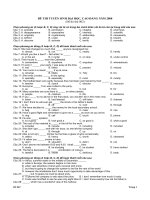TAPESCRIPT tieng anh 9
Bạn đang xem bản rút gọn của tài liệu. Xem và tải ngay bản đầy đủ của tài liệu tại đây (42.13 KB, 7 trang )
HNV 2010
Unit 1: A visit form a pen pal.
Tape transcript:
Tim:
Carlo:
Tim:
Carlo:
Tim:
Carlo:
Tim:
Carlo:
Tim:
Carlo:
Tim:
Carlo:
Tim:
Are you hungry Carlo?
Yes
Okay. Let’s go to a restaurant downtown. If we go through
the park, we can catch a bus on Ocean Drive.
That s fine. I really like walking in the park. You’re lucky to
have a place like this close to your home. It’s so beautiful
with all the trees and flowers and a pond in the middle.
Carol! Be careful. You’re walking on the grass. The park
keeper is growing some more- You’ll kill the new grass!
Oh, sorry. I didn’t see the sign.
Come on. It’s time we caught the bus.
Is that our bus, Tim?
No. That ‘s a 103 bus. We want the number 140.
Where are you going to eat?
It’s up to you. There’s a new Mexican restaurant in town.
Oh, no. I can eat Mexican food at home. I love American
food. I’d rather eat hamburgers.
Okay. I know exactly where we need to go!
-------the end-------Unit 2: Clothing
Tape transcript: Announcer (On Public Announcement)
Attention please. Here is a special announcement. A little girl is
reported missing. She was last seen 20 minutes ago near the train
entrance to the car Fair. Her name is Mary and she is 3 years old. She
has short dark hair. She’s wearing shorts – blue shorts and a long
sleeved white blouse. She’s wearing a pairs of shoes- brown shoes. She
may be carrying a large doll.
If you see Mary, Please bring her to the Information Desk. Her father’s
waiting for her there. Thank you.
-----------the end--------
1
HNV 2010
Unit 3: A trip to the countryside.
Tape Transcript:
At 6.30 in the morning, the bus collected BA and his father from their
home. After picking everyone up, the bus continued north on Highway
Number 1. It crossed the Dragon Bridge and stopped at the gas station
to get some more fuel. Then, it left the highway and turned left onto a
smaller road westward. This road ran between green paddy fields, so
the people on the bus could see a lot cows and buffaloes. The road
ended before a big store beside a pond. Instead of turning left towards
a small airport, the bus went in the opposite direction. IT didn’t stay on
that road for very long, but turn left onto the road which went through
a small bamboo forest. Finally, the bus dropped everyone off at the
parking lot ten meters from a big old banyan tree. IT parked there and
waited for people to come back in the evening.
------------the end-----------------Unit 4: Learning a foreign language.
Tape Transcript:
-
- Host:
Kate, can I introduce you to Nga? She’s studying
English here in London.
- Kate:
Hello, pleased to meet you.
- Nga:
Pleased to meet you, too.
- Kate:
Where are you from Nga?
- Nga:
I am from VietNam.
- Kate:
Why are you studying English here?
Nga:
I need it for my job.
Kate:
Really? So, What do you do?
Nga:
I work for a bank, an international bank in HaNoi.
Kate: Oh, I see. Did you learning English at school?
Nga:
Yes, and at university,too. I ‘ve for get er……forget…
Kate:
Forgotten.
2
HNV 2010
- Nga :
Yes, of course. I’ve forgotten a lot of it. I want to
improve my writing skills. You know….sometimes I have to write
letter in English.
- Kate:
What about listening Nga?
- Nga:
It’s terrible. This is my biggest problem. People talk very
quickly and I can’t understand them.
- Kate: Do you studying English?
- Nga:
Oh yes. It’s interesting language and it’s very useful;
and I can talk to people from all over the world… and I can
understand the words of my favorite songs, too.
- Kate:
That very good. Good luck to you, Nga.
-------------------the end------------------Unit 5: The Media.
Tape Transcript:
Chau:
Dad, I’m doing an assignment. Can You help me with
the i nformation?
Chau’s father:
What is the assignment about?
Chau:
IT about the important dates of the media. Where and
when did the first printed newspaper appear, Dad?
Chau’s father.
It first appeared in the 7th or 8th century AD, in
China.
Chau:
And when was the telegraph invented?
Chau’s father:
Perhaps it was in the late 19th century. Do you
know what two forms of news media appeared in the
early 20th century?
Chau:
Radio and newsreels?
Chau’s father:
Excellent! And when did television become
commercially viable, can you guess?
Chau:
In the 1940s?
Chau’s father:
No, it was in the 1950s.
Chau:
When did the internet become a major force in
journalism?
Chau’s Father:
In the mid- and late 1990s.
Chau:
Thank you. Dad. Now I can answer all the questions for
my assignment.
----------------the end---------------
3
HNV 2010
Unit 6: THE INVIRONMENT.
Tape Transcript:
Our oceans are becoming extremely polluted. Most of this pollution
comes from the land, which means it comes from people. Firstly, there
is raw sewage, which is pumped directly into the sea. Many countries,
both developed and developing, are guilty of doing this. Secondly,
ships drop about 6 million tons of garbage into the sea each year.
Thirdly, there are oil spills from ships. A ship has an accident and oil
leaks from the vessel. This not only pollutes the water, but it also kills
marine life. Next, there are waste materials from factories. Without
proper regulations, factory owners let the waste run directory into the
rivers, which then leads to the sea. And finally, oil is washed from the
land. This can be the result of carelessness or a deliberate dumping of
waste.
-----------the end--------------Unit 7: Saving energy.
Tape Transcript:
Are you looking for a cheap, clean, effective source of power that
doesn’t
cause pollution or waste natural resources? Look no further than
solar
energy from our sun. At present , most of our electricity comes from
the
use of coal, gas, oil, or nuclear power. This power could be provided
by
the sun. One percent pf the solar energy that reaches the Earth is
enough
to provide for the total population.
Many countries are already using solar energy. Solar panels are
placed
4
HNV 2010
on the roof of a house and the sun’s energy is used to heat water.
The
energy can stored for a number of days, so on cloudy days you can
use
solar energy too.
Sweden has an advanced solar energy program. There, all buildings
will
be heated by solar energy and cars will use solar power instead of
gas by
the year 2015.
&&&&&&&&&&&&&&&&&&&&&&&&&&
Unit 8: Celebration.
Tape Transcript
Auld Lang Syne
Should Auld acquaintance be forgot
And never brought to mind?
Should auld acquaintance be forgot and days of auld lang syne?
For auld lang syne, my dear,
For Aulang syne,
We’ll take a cup of kindness yet,
For auld lang syne.
Should Auld acquaintance be forgot
And never brought to mind?
Should auld acquaintance be forgot
and days of auld lang syne?
And here’s a hand , my trusty friend and gie’s a hand o’ thine
We’ll tak’ a cup o’ kindness yet
5
HNV 2010
For auld lang syne.
------------------the end--------------------Unit 9: Natural disasters
Tape Transcript
If you live in an earthquake Zone, you should take some time to
look around your house. Place heavy books on the
bottom shelf of your bookshelves. Block the rollers on
your fridge and washing machine to prevent them from
moving. Put hanging potted plants in plastic containers.
Check the mirrors in your bathroom and bedroom. Make
sure they can’t move. Don’t put your bed to a window.
Planning where you are going to be during an earthquake is very
importance. The first thing to remember is to stay
inside. Then you should sit under a strong table or
doorway, or stand in the corner of a room.
----------the end---------Unit 10. Life on other planets.
Tape transcript.
Goodevening. Welcome to our Science for Fun Program. This
week
we’ve received a lot of questions asking about life on the moon.
We’ve
talked to some experts and this is what we’ve found out. There is no
water
or air on the moon. It is all silent because there is no air. Of course
there
will be no music, no sounds. There are no rivers and no lakes. At
night it
is very cold. The temperature goes down to 151oC below Zero. But
during the day the temperature rises to 100oC above Zero.
There are great round holes on the moon. They look like big lakes.
They
are called craters. There are more than 30.000 craters on the moon.
There
6
HNV 2010
are also high mountains. The highest mountains on the moon are
about
26.000 feet or 8.000 meters high.
And here is something very interesting to know on the moon you
weigh
one sixth of what you weigh on earth. If you weigh 50 kilos, on the
moon
you will weigh only a little more than 8 kilos. You will be able to jump
very high, even higher than an Olympic Champion. You can take
very
long step as well . and … May be you won’t sleep very well because
one
day on the moon lasts for 2 weeks.
So, is there life on the moon? I’ll leave the question for you to
answer
yourself.
------------The end-------------------------
7









